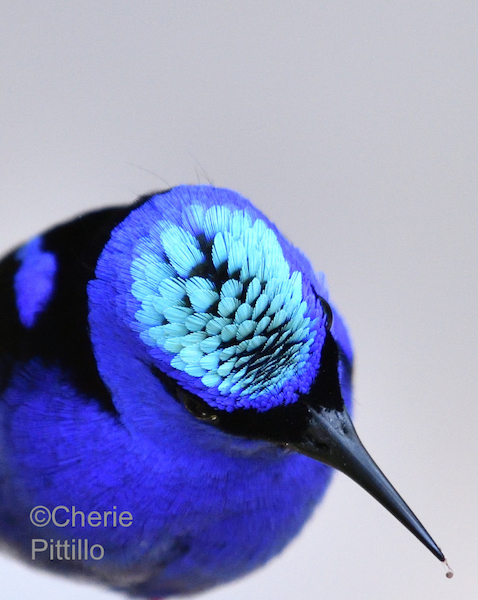Is “honeycreeper” an oxymoron? One thinks of “honey” as something sweet, but even mention the word “creep” and many would think of a sneaky, nefarious person lurking in the shadows.
In the bird world, honeycreepers belong to the large family of tanagers, but there are true honeycreepers and evidently false ones. Thanks to recent DNA sequencing, the commonly called Hawaiian Honeycreeper belongs to an ancestor of the Eurasian rosefinch (one word), not honeycreepers. True honeycreepers fall into three genera, Chlorophanes, such as the Green Honeycreeper, Cyanerpes including the Red-legged and also Shining Honeycreepers, all pictured below, and Iridohanes, a Golden-collared Honeycreeper which I’ve never seen yet in South America.



The name derives from feeding on nectar, not honey. At least the various sugary components of nectar are the main ingredients in honey. Of the three true species of honeycreepers used to illustrate this story, both the four inch Shining Honeycreeper and Red-legged Honeycreeper probe/pierce flowers with their thin, down-curved bills adapted to gather honey, uh, nectar. However, the larger five and a half inch Green Honeycreeper exhibits a thicker beak and doesn’t depend on nectar as much as the others. These species primarily eat fruit, arthropods and insects, and nectar (alias honey).






Not only has the name caused confusion, but an egg catalog from 1899 claimed honeycreepers laid black-shelled eggs in pouch nests. The collection information came from hunters rather than scientists but the publisher included the black eggs anyway and later references continued to concur. Finally, in 1945, a scientist studied nest building and egg laying of the Green Honeycreeper. He recorded light-colored, speckled eggs, not black ones, in several small cup-shaped nests, not pouches. Other honeycreeper species do the same.
In nest building, each referenced female is the architect. Generally the male may go with her while she collects nest materials, but he doesn’t assist in nest construction and may preen and rest near her while she works. However, after she incubates eggs, both parents feed the chicks.
Female honeycreepers usually look different from the males (sexual dimorphism). However the red-legged wears a turquoise crown during breeding season and then turns green like the female the rest of the year, a rare occurrence in resident tropical birds. (I don’t have a good image of that female.) Besides the vivid plumage colors, both the red-legged and shining sport kinky boots. On the other hand, the Green Honeycreeper male looks turquoise from a distance but also may have green in its feathers while the female and juveniles are all green. ( A common name that works for the female!)





Both the Red-legged and the Green Honeycreepers seem hyperactive and are found in the Yucatan as permanent residents while the shining appears just south in Guatemala and beyond. Needless to say they all live in humid forest edges near flowering and fruit trees, plantations, and even gardens. More than 20 subspecies of true honeycreepers range from southern Mexico down to upper half of South America.

WHEN YOU’RE HYPERACTIVE, A FIVE MINUTE ESCAPE IN NATURE WILL SOOTHE YOU.
REFERENCED PHOTOS:
Red-legged Honeycreeper, Cyanerpes cyaneus, Mielero Patas Rojas (Spanish), Tsu ‘ust kaab (Mayan)
Shining Honeycreeper, Cyanerpes lucidus, Mielero Luciente (Spanish)
Green Honeycreeper, Chlorophanes spiza, Mielero Verde (Spanish)
DISCLAIMER: References do not agree on details about these species:
Sal a Pajarear Yucatan, Birds & Reserves of the Yucatan Peninsula, A Guide to the Birds of Mexico and Northern Central America, A Bird Watcher’s Adventures in Tropical America, A Guide to the Birds of Costa Rica, The Birds of Panama A Field Guide, The Birds of South America Volume 1
Cherie Pittillo, “nature inspired,” photographer and author, explores nature everywhere she goes. She’s identified 56 bird species in her Merida, Yucatan backyard view. Her monthly column features anecdotes about birding in Merida, Yucatan and also wildlife beyond the Yucatan.
Contact: [email protected] All rights reserved, ©Cherie Pittillo

